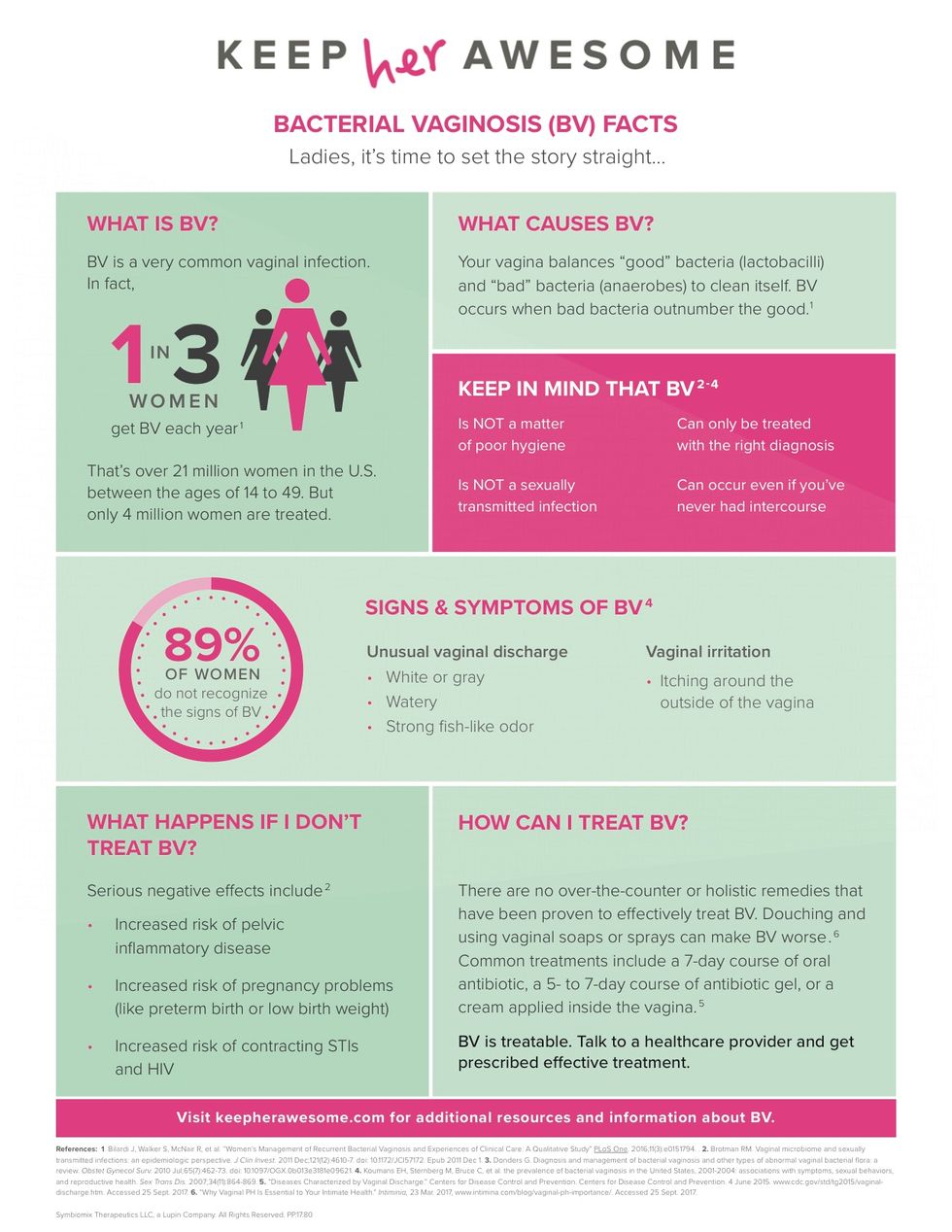Stop ignoring your vagina. It could be trying to tell you something important.
If you've ever experienced thin, milky vaginal discharge that may also have a strong, fishy odor, you may have had bacterial vaginosis (BV). It's the most common vaginal infection in women of childbearing age.
In a recent survey of 1,969 women, conducted by HealthyWomen in partnership with Symbiomix Therapeutics, over 65 percent of respondents said they felt anxious, depressed, ashamed or embarrassed about BV. But BV is so common that no woman needs to feel this way. It affects approximately 21 million U.S. women—nearly one-third of the female population.
Many women mistakenly confuse BV discharge with yeast infection discharge, which is odorless, thick and white. If you thought you had a yeast infection only to later find out it was BV, you're not alone. That same survey found that the majority of those surveyed—60 percent—said they thought that maybe a yeast infection was the cause of their abnormal discharge. Among respondents who were eventually diagnosed by a health care professional, three-fourths were diagnosed with BV and only about 10 percent with a yeast infection.
Many women with vaginal discharge either don't see their health care provider or wait a long time to do so. Almost 40 percent of survey respondents waited one month or more to visit a health care professional about their abnormal vaginal discharge. And, understandably, nearly 40 percent waited and hoped for their symptoms to go away.
Though we've all been there and done that, misdiagnosis often occurs when women try to self-diagnose, self-treat or completely ignore their abnormal discharge—hoping it will go away on its own. The only way to be sure you have BV is to visit your health care professional.
Ignoring or misdiagnosing BV may lead to a number of possible complications. Without treatment, or with the wrong treatment, the infection may worsen.
Though BV is not sexually transmitted and occurs when there is an imbalance in the vaginal pH, it can increase your risk for a sexually transmitted disease, including chlamydia, gonorrhea trichomoniasis, HPV, syphilis and even HIV, if you are exposed to it from an infected partner.
Left untreated, BV can sometimes cause pelvic inflammatory disease, which can harm your reproductive organs and lead to infertility. And finally, BV puts you at greater risk for an infection following any gynecologic surgery or procedure.
BV is easily treated, and there are many available options, which include antibiotics, prescribed as oral tablets or as topical creams that are applied inside the vagina. The treatments get rid of the bacteria causing the infection. Some treatments also leave the good bacteria intact to support a healthy vaginal microbiome.
It's important to complete the full course of treatment, even if your symptoms disappear, because stopping antibiotics prematurely can increase the risk of a recurrence.
The following factors put you more at risk for BV:
- Having a new sex partner or multiple sex partners (although it is possible to get the infection if you've never had sex)
- Douching
- Not using condoms
- Being African American or Latina
- Pregnancy
One in four pregnant women will develop BV, which can occur at any point during pregnancy. Ignoring symptoms and not being treated can increase the risk of preterm labor and birth, as well as having a low–birth-weight baby.
If you experience any abnormal discharge, see your health care provider to determine the cause. If it is BV, no big deal—talk to your health care provider about your symptoms and your treatment options.
For more information on BV, check out the infographic and visit
KeepHerAwesome.Com.
References
- https://www.cdc.gov/std/bv/stdfact-bacterial-vaginosis.htm
- https://www.cdc.gov/std/bv/stats.htm.
- https://www.nichd.nih.gov/health/topics/vaginitis.
- Survey results from “Do You Really Know What's Causing Your Discharge?" (online survey conducted by HealthyWomen and Symbiomix Therapeutics, LLC, in the first quarter of 2017). Results on file with HealthyWomen and Symbiomix Therapeutics, LLC. 2017.
- https://www.health.harvard.edu/a_to_z/bacterial-vaginosis-gardnerella-vaginitis-a-to-z
- https://www.mayoclinic.org/diseases-conditions/bacterial-vaginosis/diagnosis-treatment/treatment/txc-20198421
- https://www.womenshealth.gov/a-z-topics/bacterial-vaginosis#references
- https://www.womenshealth.gov/a-z-topics/bacterial-vaginosis








